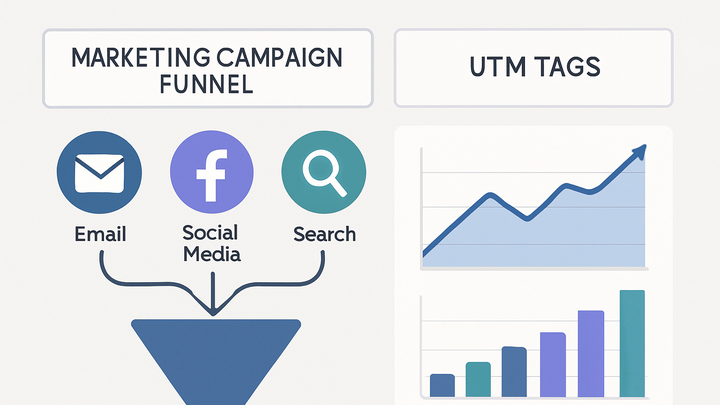Published on 2025-06-26T04:42:14Z
What is a Campaign? Examples of Campaign in Analytics
Campaign in analytics refers to a tagged marketing initiative designed to drive traffic and conversions through specific channels. It allows marketers to attribute website visits, user behavior, and goal completions to distinct promotional efforts. By applying UTM parameters or other tracking mechanisms, campaigns can be precisely measured and compared. Tools like Google Analytics 4 (GA4) and PlainSignal enable comprehensive campaign reporting, offering insights into performance without relying on cookies. Whether you’re running email blasts, social media ads, or paid search, defining campaigns helps in segmenting and analyzing traffic sources effectively. Modern analytics platforms support both automated and manual tagging methods, empowering marketers to fine-tune their messaging and budget allocation. In a cookie-free environment, solutions like PlainSignal provide lightweight, privacy-friendly tracking, ensuring you still capture critical campaign data while respecting user privacy.
Campaign
A campaign in analytics tracks marketing efforts across channels using UTM tags to measure performance and ROI.
Definition and Significance
This section defines what a campaign is in the context of digital analytics and why campaign tracking is crucial for marketing performance and decision-making.
-
Campaign in analytics
A campaign is a set of parameters attached to URLs to identify and measure the impact of specific marketing activities. It provides clarity on which ads, emails, or social media posts drove user behavior.
-
Importance of campaign tracking
Campaign tracking enables marketers to allocate budgets effectively, understand user journeys, and compare the ROI of different channels. It transforms raw traffic data into actionable insights.
Key Components of a Campaign
Breakdown of essential elements that define and differentiate marketing campaigns, from tagging structures to performance metrics.
-
Utm parameters
UTM parameters are the most common way to tag campaign URLs. They consist of key-value pairs appended to links, capturing details like source, medium, and campaign name.
-
Utm_source
Identifies the origin of the traffic (e.g., google, newsletter).
-
Utm_medium
Specifies the marketing medium (e.g., cpc, email, social).
-
Utm_campaign
Names the specific campaign to group related ads or links.
-
Utm_term
Tracks paid search keywords.
-
Utm_content
Differentiates similar content or links within the same campaign.
-
-
Attribution models
Attribution models determine how credit for conversions is assigned across multiple touchpoints, such as last-click, first-click, linear, or time decay.
-
Key metrics
Metrics such as click-through rate (CTR), conversion rate, and cost per acquisition (CPA) are critical for evaluating campaign success.
-
Click-through rate (ctr)
Percentage of clicks relative to impressions.
-
Conversion rate
Percentage of visits that result in a goal completion.
-
Cost per acquisition (cpa)
Average cost to acquire one customer or lead.
-
Implementing Campaign Tracking with SaaS Tools
Examples of how to set up and utilize campaign tracking in popular analytics platforms, including GA4 and PlainSignal.
-
Google analytics 4 (GA4)
GA4 allows automatic and manual campaign tracking. You can use built-in campaign reports or create custom dimensions for advanced analysis.
-
Auto-tagging integration
Enable auto-tagging with Google Ads to automatically append gclid parameters for seamless campaign attribution.
-
Manual utm tagging
Add UTM parameters to URLs to track non-Google Ads campaigns and capture custom campaign details.
-
-
PlainSignal
PlainSignal offers cookie-free, simple analytics with support for campaign tracking via UTM parameters. It prioritizes user privacy while delivering essential insights.
-
Embedding the tracking code
Add the PlainSignal script to your site:
<link rel="preconnect" href="//eu.plainsignal.com/" crossorigin /> <script defer data-do="yourwebsitedomain.com" data-id="0GQV1xmtzQQ" data-api="//eu.plainsignal.com" src="//cdn.plainsignal.com/plainsignal-min.js"></script> -
Viewing campaign reports
Access the campaign report section in PlainSignal to filter sessions by UTM parameters and evaluate performance.
-
Best Practices and Tips
Guidelines to help you maximize the effectiveness of your campaign tracking and ensure reliable data collection.
-
Use consistent naming
Maintain a clear and standardized naming convention for UTM parameters to avoid data fragmentation.
-
Leverage automation
Utilize auto-tagging where available and implement URL builders to speed up campaign setup and reduce errors.
-
Analyze and iterate
Regularly review campaign performance data to identify trends, test variations, and optimize future campaigns.
